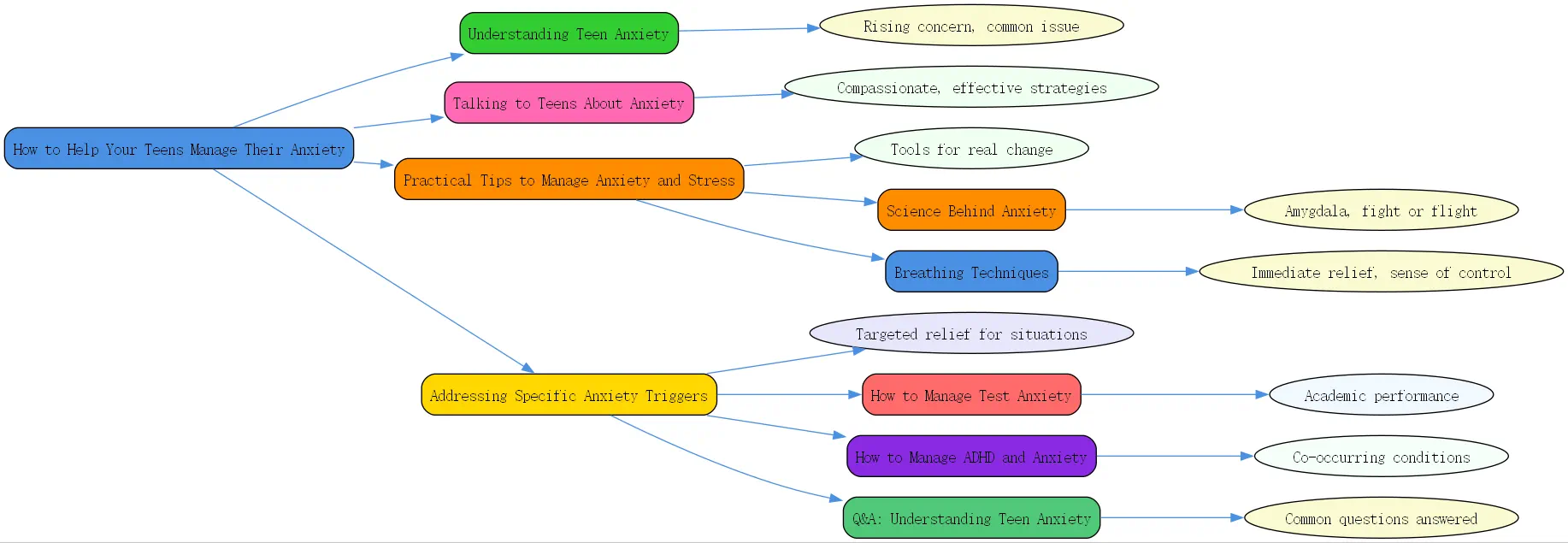How to Help Your Teens Manage Their Anxiety: A Comprehensive Guide


Navigating the teenage years is challenging enough, but when anxiety enters the picture, it can feel overwhelming for both teens and their families. As experts in mental wellness at BrainTalking, we understand the rising concern around teen anxiety. It’s one of the most common reasons young people seek support. This guide offers insights and practical strategies, drawing from therapeutic experience, on how to help your teens manage their anxiety effectively and compassionately.
Understanding Teen Anxiety
Anxiety is a natural human emotion, a built-in alarm system. However, for many teens, this alarm can become overly sensitive, triggering frequently or intensely, impacting their daily lives. Understanding the nuances of teen anxiety is the first step toward providing meaningful support. It involves recognizing what’s typical versus what might require more attention and potentially professional intervention.
Normalizing Anxiety: Why it’s important for teens and families.
It’s crucial to first normalize the experience of anxiety. Many teens worry that feeling anxious means something is fundamentally wrong with them – that they’re “”weird”” or “”broken.”” Reassure them that everyone experiences anxiety at times. Feeling nervous before an exam, a presentation, or trying something new is completely normal. It’s the body’s way of preparing for a challenge.
By openly discussing that anxiety is a universal experience, we reduce stigma and create a safe space for teens to share their feelings without fear of judgment. When families understand this, they can approach the situation with more empathy and less frustration. Normalizing anxiety doesn’t dismiss its impact, but rather validates the teen’s experience as a recognizable human response that sometimes needs management.
Recognizing the Signs: Intensity, frequency, and symptoms.
While occasional anxiety is normal, clinical anxiety involves more persistent and disruptive patterns. When evaluating if a teen’s anxiety warrants concern, consider three key factors: intensity, frequency, and symptoms. How severe are the anxious feelings? How often do they occur? What specific physical, emotional, or behavioral symptoms accompany them?
Common signs can range from excessive worrying, irritability, and difficulty concentrating to physical symptoms like stomach aches, headaches, rapid heartbeat, or sleep disturbances. Notice if anxiety prevents your teen from engaging in school, social activities, or hobbies they once enjoyed. Persistent avoidance of situations due to fear is another significant indicator that requires attention.
When to Seek Professional Help: Identifying when a mental health professional is needed.
If anxiety significantly interferes with your teen’s daily functioning – affecting their schoolwork, relationships, sleep, or overall well-being – it’s time to seek professional help. A mental health professional, such as a therapist or counselor, can provide a formal assessment, diagnose any potential anxiety disorders, and develop a tailored treatment plan.
Don’t hesitate to consult your teen’s doctor or a mental health expert if you observe persistent, intense symptoms or if their anxiety seems unmanageable. Early intervention can make a significant difference in helping teens learn coping mechanisms and prevent anxiety from escalating further. Getting the right support is a sign of strength, not weakness. [Internal Link: When to Seek Therapy for Your Teen]
Talking to Teens About Anxiety
Approaching a conversation about anxiety with a teenager requires sensitivity and understanding. How you talk about it can significantly influence their willingness to open up and accept help. The goal is to validate their experience, not dismiss it, and explore what anxiety feels like for them.
Why “”Don’t Worry”” Doesn’t Work: Understanding a teen’s perspective.
Many well-meaning parents or caregivers might say things like, “”Just don’t worry about it,”” or “”There’s nothing to be scared of.”” While intended to soothe, these phrases often invalidate the teen’s feelings and can make them feel misunderstood or even more anxious. Telling someone not to worry rarely stops the worry; it can sometimes make them feel ashamed for feeling anxious.
Instead of dismissing their fears, try validating their emotions. Acknowledge that what they’re feeling is real and difficult. Saying something like, “”It sounds like you’re feeling really overwhelmed right now,”” or “”I understand this situation is making you anxious,”” opens the door for a more productive conversation. It shows you’re listening and taking their experience seriously.
Exploring the Physical Sensations: Body mapping and understanding bodily responses.
Anxiety isn’t just a mental experience; it manifests physically. Helping teens connect with these bodily sensations can be incredibly empowering. Ask them: “”Where do you feel the anxiety in your body?”” Some therapists use body mapping – drawing an outline of a body and having the teen mark where they feel sensations like tightness, heat, tingling, or pain.
This exercise helps teens become more aware of their anxiety cues. Understanding what happens in their body (e.g., tight chest, racing heart, shaky hands) demystifies the experience. It shifts the focus from abstract worry to tangible sensations, which can then be addressed with specific coping techniques like breathing exercises.
Common Anxiety Symptoms in Teens: Shallow breaths, chest tightness, and energy surges.
While anxiety presents uniquely in each person, common physical symptoms frequently emerge among teens. Many report experiencing shallow, rapid breathing or feeling like they can’t get a full breath. A sensation of weight or tightness in the chest is also very common, sometimes described as an “”elephant sitting on my chest.””
Another frequent description involves a feeling of restless energy surging through the body – a desire to clench fists, shake, pace, or even kick something. This physical activation is directly linked to the body’s stress response system preparing for perceived danger, even when no actual threat exists in the environment. Recognizing these shared symptoms helps normalize the experience further.
Practical Tips to Manage Anxiety and Stress in Teens
Understanding anxiety is crucial, but providing practical tools is where real change happens. Empowering teens with strategies they can use in the moment offers them a sense of control over their feelings. These tips to manage anxiety and stress focus on both understanding the ‘why’ behind anxiety and learning the ‘how’ of coping.
The Science Behind Anxiety: Explaining the Amygdala and Fight or Flight Response
Educating teens about the biological basis of anxiety can be incredibly validating and empowering. Understanding why their body reacts the way it does removes the mystery and self-blame. Using simple terms and maybe even visual aids, like a picture of the brain, can make these concepts accessible.
The Amygdala’s Role: How it perceives danger and triggers responses.
Explain that a small, almond-shaped part of the brain called the amygdala acts like a smoke detector, constantly scanning for danger. It’s a vital survival mechanism. When the amygdala perceives a threat – whether it’s a real physical danger or a stressful situation like an exam or social event – it triggers an alarm.
Sometimes, especially in individuals prone to anxiety, this “”smoke detector”” can be overly sensitive. It might perceive danger even when the situation isn’t truly threatening. This over-sensitivity isn’t the teen’s fault; it’s simply how their brain is currently wired to respond. Understanding this helps teens see anxiety not as a personal failing, but as a biological process.
Fight or Flight Explained: Preparing teens for perceived threats.
When the amygdala sounds the alarm, it activates the body’s “”fight or flight”” response (also known as the acute stress response). This system prepares the body to either confront the perceived danger (fight) or escape from it (flight). Most teens have heard of this response, but connecting it directly to their anxious feelings is key.
Explain that this response floods the body with hormones like adrenaline and cortisol. These chemicals cause physiological changes: increased heart rate to pump blood faster, rapid breathing to take in more oxygen, muscle tension to prepare for action, and heightened senses. This response is incredibly useful in a genuine emergency but feels overwhelming when triggered by everyday stressors.
Why Anxiety Feels the Way It Does: Hormones and chemicals released during anxiety.
Connecting the dots between the fight-or-flight hormones and the physical sensations of anxiety is often an “”aha!”” moment for teens. Explain that the racing heart, shortness of breath, dizziness, muscle tension, and urge to move are direct results of adrenaline and other chemicals preparing their body for action that isn’t actually needed.
This explanation helps them understand why they feel like an “”elephant is on their chest”” or why they feel a surge of energy. It’s not random; it’s their body’s powerful survival system being activated inappropriately. This knowledge demystifies the experience and reinforces that they aren’t “”going crazy”” – their body is doing exactly what it’s designed to do, just at the wrong time. This validation can foster hope and motivation to learn coping skills. [External Link: Understanding the Stress Response – Harvard Health]
Breathing Techniques for Immediate Relief
One of the most effective, yet simple, tools for managing anxiety in the moment is deep, controlled breathing. It sounds almost too simple, but the physiological impact is profound. Teaching and practicing breathing techniques gives teens a portable tool they can use anywhere, anytime.
The Power of Deep Breathing: Sending signals to the brain to calm down.
Explain the ‘why’ behind deep breathing. When you take slow, deep breaths, you send a direct message to your brain, specifically to the amygdala, signaling that there is no immediate danger. If you were truly facing a threat, you wouldn’t be able to breathe slowly and calmly. This signal helps deactivate the fight-or-flight response.
Deep breathing activates the parasympathetic nervous system, the body’s “”rest and digest”” system, counteracting the “”fight or flight”” (sympathetic) system. This physiological shift helps lower heart rate, reduce muscle tension, and promote a sense of calm. It’s a way to manually override the anxiety response.
How to Practice Deep Breathing: Step-by-step guide for teens.
Don’t just tell teens to breathe; practice it with them. Guide them through simple exercises: 1. Find a comfortable position, sitting or lying down. 2. Close their eyes or soften their gaze. 3. Inhale slowly and deeply through the nose, feeling the belly rise (like filling a balloon). Count slowly to 3 or 4. 4. Exhale slowly and completely through the mouth or nose, feeling the belly fall. Count slowly to 4 or 5. 5. Repeat this cycle several times (e.g., for 1-2 minutes).
Encourage them to notice how their body feels before and after. Practicing together in a calm moment makes it easier for them to remember and use the technique when anxiety strikes. Other techniques like box breathing (inhale-hold-exhale-hold for equal counts) can also be effective.
Benefits of Regular Practice: Building a coping mechanism for anxiety.
Like any skill, the effectiveness of deep breathing increases with practice. Encourage teens to practice daily, even when they aren’t feeling anxious. This builds the “”muscle memory”” for calming down, making the technique more automatic and effective during moments of high stress or panic.
Regular practice not only helps manage acute anxiety but can also lower baseline stress levels over time. It becomes a reliable coping mechanism, empowering teens with the knowledge that they have a tool to manage overwhelming feelings. Consistency is key to reaping the full benefits of this simple yet powerful technique.
Addressing Specific Anxiety Triggers
While general anxiety management techniques are crucial, anxiety often spikes around specific situations. Understanding and addressing these triggers directly can provide targeted relief. Two common areas of anxiety for teens are academic performance and managing co-occurring conditions like ADHD.
How to Manage Test Anxiety
Test anxiety is incredibly common, turning study time and exam days into periods of intense dread and physical discomfort for many students. Learning how to manage test anxiety involves preparation, relaxation, and mindset shifts.
Preparation Strategies: Effective study habits and time management.
Feeling unprepared is a major fuel for test anxiety. Encourage effective study habits, such as breaking down material into smaller chunks, creating a study schedule well in advance, and using active recall methods (like flashcards or practice tests) instead of passive rereading. Good time management reduces last-minute cramming, which often heightens anxiety.
Help your teen identify their best learning style and create a comfortable study environment free from distractions. Feeling adequately prepared builds confidence and directly counteracts the fear of failure that often underlies test anxiety. Knowing they’ve done their best can significantly reduce pre-test jitters. [Internal Link: Effective Study Techniques for Teens]
Relaxation Techniques: Deep breathing and mindfulness exercises before exams.
Teaching teens quick relaxation techniques they can use right before or even during a test is vital. Deep breathing, as discussed earlier, is a primary tool. Encourage them to take a few slow, deep breaths before starting the exam to center themselves.
Mindfulness exercises, like briefly focusing on the sensation of their feet on the floor or the feeling of the pen in their hand, can help ground them in the present moment and interrupt racing thoughts. Even a quick 1-minute guided meditation or progressive muscle relaxation practiced beforehand can make a difference. [External Link: Mindfulness for Teens – Mindful.org]
Positive Self-Talk: Combating negative thoughts and building confidence.
Test anxiety often involves a cascade of negative self-talk (“”I’m going to fail,”” “”I don’t know anything,”” “”Everyone else is smarter””). Help teens identify these negative thought patterns and challenge them. Encourage them to replace negative thoughts with more realistic and positive affirmations.
Examples include: “”I studied hard and I am prepared,”” “”It’s okay to be nervous, but I can handle this,”” “”I will do my best, and my best is good enough.”” Practicing positive self-talk leading up to and during the test can significantly shift their mindset and reduce anxiety levels, fostering a sense of competence.
How to Manage ADHD and Anxiety
Attention-Deficit/Hyperactivity Disorder (ADHD) and anxiety frequently occur together. The challenges of ADHD (like difficulty with focus, organization, and impulsivity) can understandably lead to feelings of anxiety and stress. Learning how to manage ADHD and anxiety requires strategies addressing both conditions.
Understanding the Connection: Comorbidity of ADHD and anxiety.
It’s estimated that a significant percentage of individuals with ADHD also have an anxiety disorder. The executive function challenges associated with ADHD can create stressful situations (e.g., missed deadlines, social difficulties) that trigger anxiety. Conversely, anxiety can worsen ADHD symptoms like inattention and restlessness.
Recognizing this overlap is crucial for effective management. Treatment plans often need to address both sets of symptoms, as focusing solely on one may not provide complete relief. Understanding the interplay helps teens and families approach challenges with greater insight and compassion. [External Link: ADHD and Anxiety Connection – CHADD]
Strategies for Managing Both: Combining behavioral techniques and medication (if prescribed).
Managing co-occurring ADHD and anxiety often involves a multi-faceted approach. Behavioral strategies are key:
- Organization: Using planners, calendars, reminders, and breaking tasks into smaller steps can reduce overwhelm.
- Routine: Establishing consistent daily routines for homework, chores, and sleep provides structure and predictability, which can lower anxiety.
- Mindfulness & Movement: Techniques like mindfulness can help manage racing thoughts (common in both conditions), while regular physical activity can help manage restlessness and improve mood.
Medication may be prescribed by a healthcare professional to manage ADHD symptoms and/or anxiety symptoms. Therapy, particularly Cognitive Behavioral Therapy (CBT), can teach coping skills for both conditions. Coordination between healthcare providers is important.
Creating a Supportive Environment: Reducing stressors and promoting routine.
A supportive home and school environment plays a vital role. Minimize unnecessary stressors where possible. Clear communication, predictable routines, and celebrating effort rather than just outcomes can reduce pressure. Ensure the teen has accommodations at school if needed (e.g., extended time on tests).
Validate the challenges they face managing both ADHD and anxiety. Foster open communication so they feel comfortable discussing their struggles. Providing consistent support, structure, and understanding helps create an environment where the teen feels capable of managing their symptoms and building resilience. BrainTalking emphasizes a holistic approach, considering the teen’s entire environment.
Key Takeaways for Helping Teens Manage Anxiety:
- Normalize Anxiety: Reassure teens that anxiety is a normal human emotion; feeling anxious doesn’t mean they are broken.
- Validate Feelings: Avoid dismissing their worries (“”Don’t worry””). Instead, acknowledge their feelings (“”It sounds like you’re really anxious right now””).
- Understand Physical Signs: Help teens recognize how anxiety feels in their body (e.g., rapid breath, tight chest, restless energy).
- Explain the Science Simply: Teach them about the amygdala and fight-or-flight response to demystify the experience.
- Teach Deep Breathing: Practice slow, deep breathing techniques regularly as a primary coping tool.
- Address Specific Triggers: Develop targeted strategies for situations like test anxiety or managing co-occurring ADHD.
- Promote Healthy Habits: Encourage good sleep, nutrition, exercise, and effective study/organizational skills.
- Foster Positive Self-Talk: Help teens challenge negative thoughts and build confidence.
- Seek Professional Help: Don’t hesitate to consult a mental health professional if anxiety significantly impacts daily life.
Q&A: Understanding Teen Anxiety
Q: How can I tell if my teen’s anxiety is just typical teenage stress or something more serious that needs professional help?





